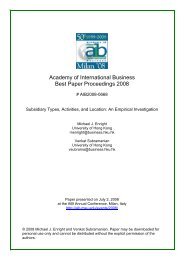AIB 2012 Conference Proceedings - Academy of International ...
AIB 2012 Conference Proceedings - Academy of International ...
AIB 2012 Conference Proceedings - Academy of International ...
Create successful ePaper yourself
Turn your PDF publications into a flip-book with our unique Google optimized e-Paper software.
TUESDAY<br />
Interarrival times between foreign entries into the Japanese banking industry are examined. We develop<br />
hypotheses on how the relationship between a prior entry and the likelihood <strong>of</strong> a subsequent entry varies over<br />
time. Piecewise-constant hazard models reveal a negative relationship, but with a spike in the pattern occurring<br />
after a number <strong>of</strong> months. It is theorized that the overall pattern is caused by coalescence, lagged imitation<br />
effects, and the weakening <strong>of</strong> these effects. These results allow scholars <strong>of</strong> (foreign) market entry to bridge the<br />
gap between interorganizational-level theories that do not consider the time dimension to their effects, and<br />
empirical models that require the specification <strong>of</strong> a time dimension <strong>of</strong> variables. (For more information, please<br />
contact: Joeri van Hugten, Tilburg University, Netherlands: j.g.w.j.vanhugten@tilburguniversity.edu)<br />
Policy Issues, Firm's Characteristics and Foreign Direct Investment<br />
Miguel Matos Torres, University <strong>of</strong> Aveiro<br />
Celeste Amorim Varum, University <strong>of</strong> Aveiro<br />
Firm's competencies may determine its actions. Firm may use its own competencies to establish or maintain<br />
activities <strong>of</strong> foreign direct investment, or otherwise when internal competencies are not sufficient or the<br />
conditions <strong>of</strong> investment too demanding it may cooperate with other firms through international joint ventures,<br />
international alliances, with locals, firms <strong>of</strong> home country and third countries or develop a strategy that includes<br />
an arrangement to apply for external support provided by governments. With a binary probit model applied on<br />
a recent survey, a Bayesian filter calculates the probability <strong>of</strong> a given characteristic's and the use <strong>of</strong> certain<br />
public support is related with the existence <strong>of</strong> foreign direct investment. The results show that some<br />
characteristics like the size, labour productivity, age, and domestic ownership, have a noticeable effect on the<br />
existence <strong>of</strong> foreign direct investment. In terms <strong>of</strong> use <strong>of</strong> public support, there is evidence <strong>of</strong> measures that<br />
promote informational services, fiscal benefits, and protocols between governmental agencies and banks have<br />
positive effects on existence <strong>of</strong> foreign direct investment. This study may add useful information to help<br />
scholars and policy makers to understand the role <strong>of</strong> competencies on the development <strong>of</strong> activities abroad.<br />
(For more information, please contact: Miguel Matos Torres, University <strong>of</strong> Aveiro, Portugal:<br />
miguel.torres@ua.pt)<br />
Session: 3.2.15 - Interactive<br />
Track: 1 - Institutions, Governance, and CSR<br />
Social Dimensions <strong>of</strong> <strong>International</strong> Business<br />
Presented On: July 3, <strong>2012</strong> - 10:45-12:00<br />
Chair: Michael Sartor, University <strong>of</strong> Western Ontario<br />
Social Disclosure <strong>of</strong> Brazilian and UK Firms in Light <strong>of</strong> Institutional Theory<br />
Marcelle Colares Oliveira, Universidade de Fortaleza<br />
Jonas Ferreira Araujo Junior, Universidade de Fortaleza<br />
Oderlene Vieira Oliveira, Universidade de Fortaleza<br />
Vera Maria Rodrigues Ponte, Universidade Federal do Ceara<br />
Maísa de Souza Ribeiro, University <strong>of</strong> São Paulo<br />
The objective <strong>of</strong> the study was to identify the main characteristics <strong>of</strong> social information disclosure <strong>of</strong> the top 30<br />
Brazilian and top 30 UK public firms (Forbes Global 2000 ranking) compared against a set <strong>of</strong> 15 indicators<br />
recommended in the UN Guidance on Corporate Responsibility Indicators in Annual Reports, and to analyze<br />
disclosure patterns in light <strong>of</strong> Institutional Theory. The study was explorative and based on information<br />
retrieved from social reports and accounting statements. The frequency distribution <strong>of</strong> the data, mean values<br />
and equality <strong>of</strong> means were determined. The most frequently disclosed indicators were "total revenues",<br />
<strong>AIB</strong> <strong>2012</strong> <strong>Conference</strong> <strong>Proceedings</strong><br />
Page 219

















